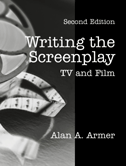“A wonderful basic textbook for people new to the field of screenwriting. It’s very useful for beginners, but intelligent enough that good students making the foray into screenwriting for the first time also find value in it.” —Alexis Krasilovsky, California State University, Northridge
“I’ve read nearly every book written on the craft of screenwriting in the last ten years. I gauge the book’s significance to my understanding of this art by the number of dog-eared pages. I can confidently exclaim that Armer’s book is dog-eared and underlined more than any other. His approach goes much deeper than most and is not the same old ‘paradigm’ that fills nearly every other book on the subject. This is for the writer who wants to stand out from the rest.” —Terry J. Linehan, University of North Carolina
“This text succinctly presents the basics of screenwriting. I like the discussion on structure.” —Margaret Kelso, Humboldt State University
“This book provides clear and useful advice. . . . An intelligent, practical discussion of the fundamentals of putting a raw idea into final, finished, and marketable form. It is good to have the guidance of a successful professional such as Alan Armer.” —Steven Bidlake, Central Oregon Community College

314 pages, $53.95 list
1-57766-233-4
978-1-57766-233-4
© 1993
paperback
Writing the Screenplay
TV and Film
Second Edition
A well-written screenplay is the single most important ingredient in making a successful motion picture or television show. Alan Armer mixes time-honored theory with down-to-earth practical advice, giving beginning and advanced students the benefits of his experiences in both the entertainment industry and the college classroom. He balances professional screenwriting methods with techniques that explain and clarify those methods for students. What truly makes this text vital is his knack for tapping the creative spirit of aspiring screenwriters to become competent writers who can deliver fresh stories that “glow in the dark.” Essential topics include organization and structure, conflict, dimensional characters, dialog, subtext, comedy, the profession, among others. Candid, personal discussion by top industry professionals; examples, anecdotes, and scenes from popular films; and challenging screenwriting projects illuminate the realities of successful screenwriting.
Reactions
1. The Blank Page: Where Stories Come From
2. Structure, Structure, Structure!
3. Anatomy of a Screenplay
4. Characters at War
5. The People Who Inhabit a Screenplay
6. Dialog
7. More about Dialog: Techniques and Taboos
8. Revealing the Subtext: What Scenes Are All About
9. Elements of Entertainment
10. Format and Style
11. Comedy
12. Adaptation
13. Launching Your Writing Career: Practical Realities of the Marketplace
Glossary
2. Structure, Structure, Structure!
3. Anatomy of a Screenplay
4. Characters at War
5. The People Who Inhabit a Screenplay
6. Dialog
7. More about Dialog: Techniques and Taboos
8. Revealing the Subtext: What Scenes Are All About
9. Elements of Entertainment
10. Format and Style
11. Comedy
12. Adaptation
13. Launching Your Writing Career: Practical Realities of the Marketplace
Glossary